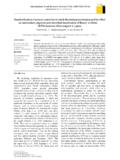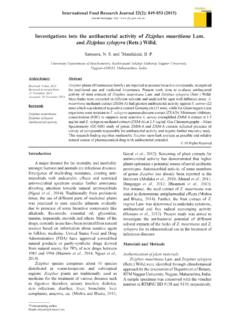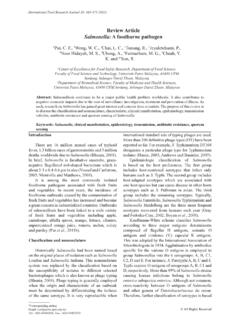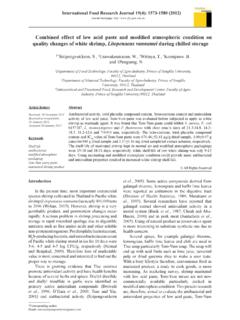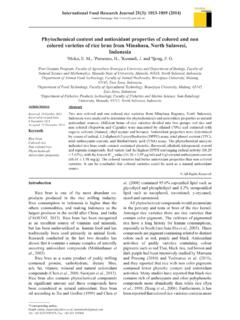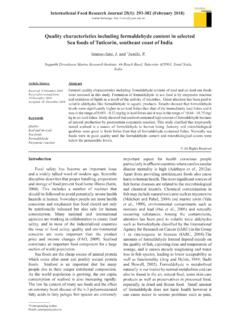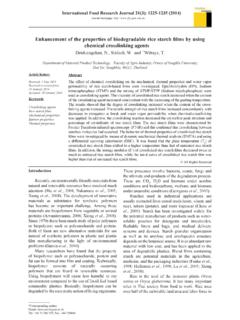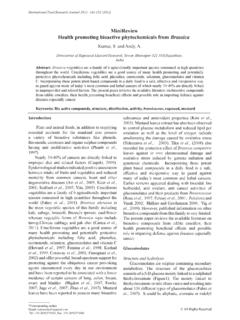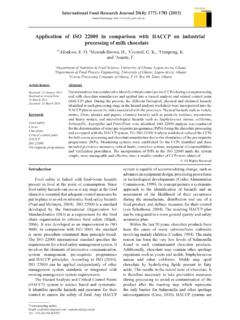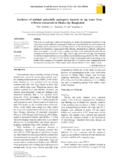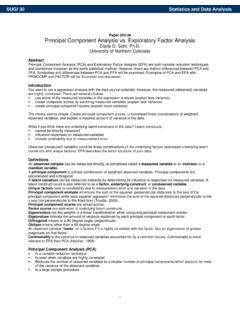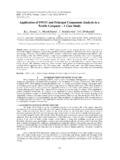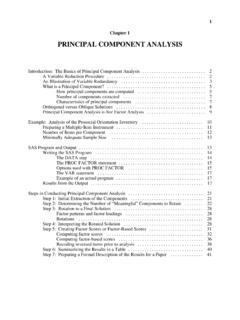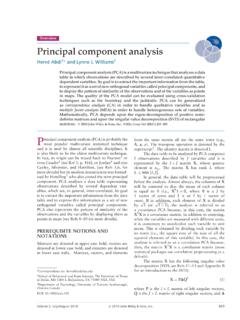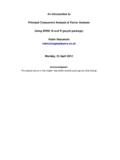Transcription of Differentiation of lard and other animal fats based on ...
1 All Rights Reserved*Corresponding author. Email: +62274-543120; Fax: +62274-543120 International Food Research Journal 19(2): 475-479 (2012)1,2*Rohman, A., 1,3 Triyana, K., 1,2 Sismindari and 1,4 Erwanto, Center of Halal Products, Gadjah Mada University, Yogyakarta, 55281 Indonesia2 Department of Pharmaceutical Chemistry, Faculty of Pharmacy, Gadjah Mada University, Yogyakarta, 55281 Indonesia3 Department of Physics, Faculty of Matematics and Natural Sciences, Gadjah Mada University, Yogyakarta, 55281 Indonesia4 Faculty of animal Sciences, Gadjah Mada University, Yogyakarta, 55281 IndonesiaDifferentiation of lard and other animal fats based on triacylglycerols composition and principal component analysisAbstract: The composition of triacylglycerol (TAG) for the Differentiation of lard and other animal fats (beef, mutton, and chicken fats) as well as cod liver oil (CLO) has been investigated using high performance liquid chromatography with refractive index detector.
2 The authenticity of the used samples was determined based on their fatty (FA) acid profiles. FA compositions of the studied fats and oils were determined with gas liquid chromatography. The main TAGs composing lard are palmitooleoolein (POO), palmitooleostearin (POS), and palmitooleopalmitin (POP) accounting of , , and , respectively. The TAG composition was further subjected to principal component analysis in order to classify lard and others. Lard was separated along negative side, either in the first principle components (PC1) and second principle components (PC2). Using score plot of PCA, lard has the similarity with chicken fat in term of TAG : : Lard, triacylglycerol, HPLC, principal component analysisIntroductionLard, one of the pig derivatives, is obtained from the rendering of adipose tissue of pig.
3 In some countries, lard is one of the cheapest edible fats and oils; consequently, lard is deliberately added into the food products to reduce the production cost (Che Man and Sadzili, 2010). From the religious point of view, the presence of lard in any food products is not allowed. For this reason, several analytical methods either physical or chemical based -methods have been developed to identify lard (Rohman et al., 2010). The animal fats, including lard, and vegetable oils were mainly composed from triacylglycerols (TAG), diacylglycerols (DAGs), free fatty acids ant other minor components like phospholipids, sterols, tocopherols, carotenoids, and fat soluble vitamins (Gunston, 2004), however, the main classes found in fats and oils are TAGs (Andrikopolous et al., 2002).
4 Therefore, this study was directed to differentiate lard and other animal fats based on the levels of TAGs in fats and oils. Che Man et al. (2011) have differentiated lard from other animal fats using Fourier transform infrared spectra in combination with chemometrics of principal component analysis and cluster analysis . However, using literature searching, there is no available report related to the application of principal component analysis using TAG data as matrix variables of lard and other animal fats. For this reason, in this study, we exploited the TAG composition for such Differentiation . Several analytical methods have been developed to analyze TAGs quantitatively. One of the most used techniques is high performance liquid chromatography (HPLC) (Rashood et al.)
5 , 1996; Yoshida et al., 2009). Using HPLC technique, the parameter used for characterization and separation of TAGs was equivalent carbon number or ECN, which is defined by the following equation: ECN = the number of carbon 2nwhere n is the number of double bonds per TAG present in three fatty acids composed TAG (Buchgraber et al., 2004; de la Mata-Espinosa et al., 2011). The objective of the present study is to differentiate lard from other animal fats (chicken, beef, and mutton fats) as well as cod liver oil) using TAG composition in combination with the chemometrics of principal component analysis . Materials and MethodsSample preparationAll reagents and solvents were bought from E. Merck (Darmstat, Germany). Lard and other animal fats were prepared by rendering adipose tissues of the corresponding animals, obtained from some 476 Rohman, A.
6 , Triyana, K., Sismindari and Erwanto, Food Research Journal 19(2): 475-479slaughtered houses in Yogyakarta. The rendering process was carried out according to previously reported publication by Rohman and Che Man (2009a). Adipose tissues of pig (lard), chicken, mutton, and beef were cut into small pieces, mixed, and melted at 90 100oC for 2 h in the conventional oven. The melted fat was strained through triple-folded muslin cloth, dried by the addition of anhydrous Na2SO4 and then centrifuged at 3000 rpm for 20 min. The fat layer was decanted, shaken well and centrifuged again before being filtered through Whatman paper containing Na2SO4 anhydrous to remove the trace of water residue. The filtered samples were directly subjected to chemical analysis or kept in tightly closed container under a nitrogen blanket in -20oC.
7 Before being used for analysis , all animal fats were thawed at water bath at 60oC until they acid compositionThe composition of fatty acids in lard and other studied edible fats and oils was determined using gas chromatography using flame ionization detector. The sample preparation and the condition of GC used can be seen in Rohman and Che Man column and carrier gas was DB-5 from Restex and helium with the purity of , respectively. Derivatization of fatty acids was carried out by methylation technique using sodium methoxyde as methylation of Triacylglycerol Quantitative analysis of triacylglycerols (TAGs) was performed according to Marikkar et al. (2011). Liquid chromatograph used was Knauer (Belin Germany) equipped with refractive index detector (Knauer, Germany).
8 The quantitative analysis of TAGs was accomplished on an Eurospher100-5 C-18 Column (Knauer, Germany) packed with a particle size of 5 m (25 cm x mm , Merck, Darmstadt, Germany). The mobile phase was a mixture of acetone acetonitrile ( : v/v) and the flow rate was 1 ml/min at 30oC. The injector volume was 10 L of 5% (w/w) the studied fats and oil in chloroform. The peak was treated with the software of Chromgate version Each sample was chromatographed three times, and the data were quantified using internal normalization technique, as described in Rohman and Che Man (2011).Statistical analysisIn order to differentiate and to classify lard, animal fats and cod liver oil, the chemometrics of principal component analysis using triacylglycerols composition as matrix variable was performed with the aid of The Unscrambler software (version ) from Camo, USA.
9 Results and DiscussionFatty acid compositionFatty acids (FAs), one of the lipid classes, are the most vital components of edible fats and oils in which they are typically found in the ester form with glycerol backbone (triglycerides). Due to the nutritional value, quantitative analysis of FAs composition is a pivotal work in food research area, especially in lipid studies (Carrosco-Pancorbo et al., 2009). In addition, FAs composition can vary from one source to another or even from one organ to others; Therefore, FAs profiles can be used for determining the purity or authenticity of animal fats (Hauff and Vetter, 2010). For this reason, we initially determine the level of FAs in the studied samples (lard and others).The fatty acid composition of lard and other animal fats (beef, chicken, and mutton) as well as cod liver oil as determined using gas chromatography with flame ionization detector is shown in Table 1.
10 These results were in agreement with those obtained by several authors (Chin et al., 2009; Indrasti et al., 2011). Compared with other evaluated samples, lard was differentiated by higher level of unsaturated fatty acids. The main fatty acids composed of lard are palmitic, stearic, oleic and linoleic acids. In addition, the level of lard is also in accordance with that listed in Codex Allimentarius (2003). based on this result, it is also can be stated that the used animal fats as well as CLO meet the fats specification. Triacylglycerol (TAG) compositionTAG composition was determined with HPLC using refractive index detector. Figure 1 showed the chromatogram of lard describing the TAG composition along with its retention time. Table 2 compiled the TAG composition of lard and others (beef fat, mutton fat, chicken fat, and cod liver oil).
